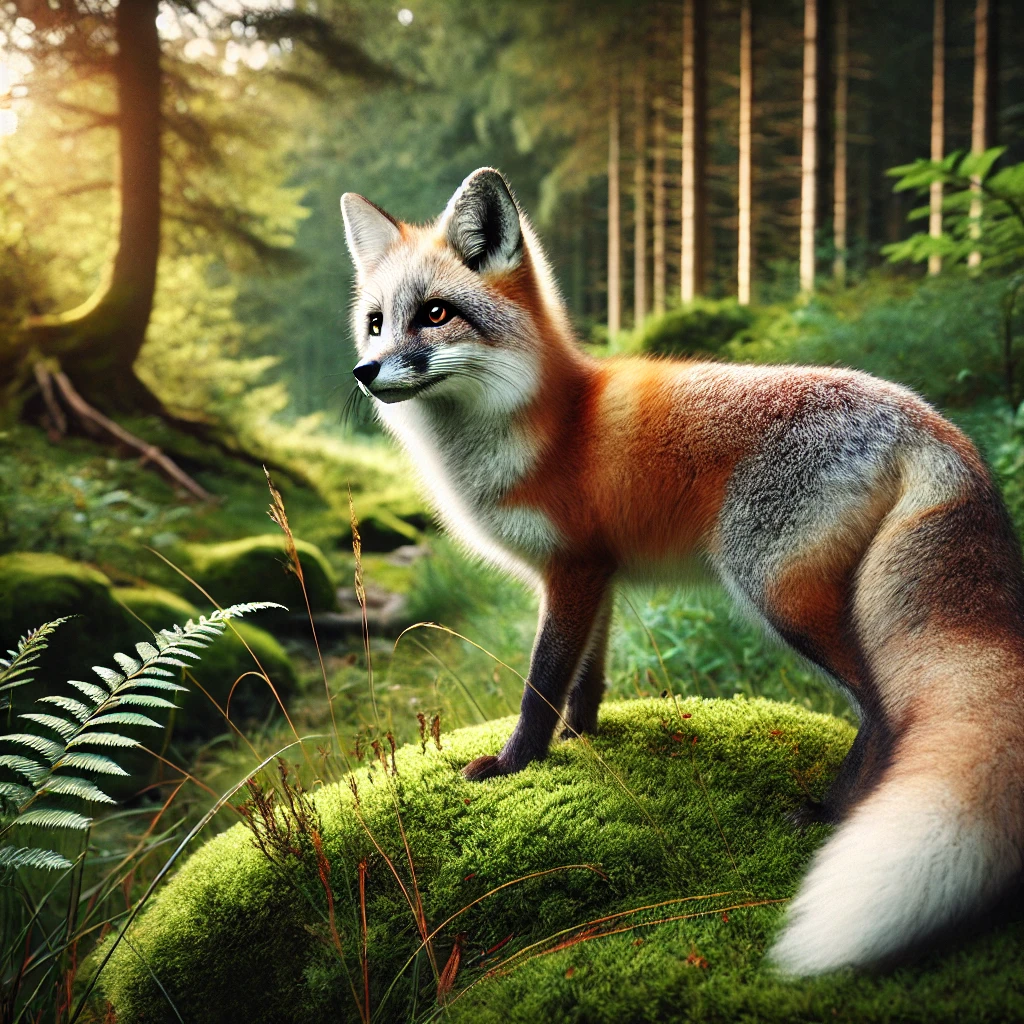Gladefoxes
The Gladefox is a cunning and adaptable predator native to the grasslands and forest edges of Trura, particularly in the Galhalon region. These agile creatures are celebrated for their intelligence, elusive nature, and striking ability to blend seamlessly with their surroundings. Revered in Truran folklore as symbols of adaptability and ingenuity, Gladefoxes play an important role in the ecosystems they inhabit.
Physical Characteristics
Gladefoxes are medium-sized foxes, with adults measuring approximately 70-90 cm (28-35 inches) in length, including their bushy tails, and standing 30-40 cm (12-16 inches) tall at the shoulder. They weigh between 6-12 kilograms (13-26 pounds), with males slightly larger than females.
- Coat and Camouflage:
One of the most remarkable features of the Gladefox is its seasonally adaptive coat, which changes color to blend with the shifting hues of its environment: - Spring and Summer: A vibrant reddish-brown coat with subtle green undertones helps it blend with the verdant grasslands and forest canopies.
- Autumn: The coat transitions to golden-brown and russet hues, mimicking the fallen leaves of the season.
- Winter: A silvery-gray or white coat provides camouflage against snow and frost-covered landscapes.
- Eyes and Vision:
Gladefoxes have large, luminous amber or green eyes adapted for low-light conditions, giving them excellent night vision for nocturnal hunting. - Build:
Their slender, athletic bodies and long legs allow them to move swiftly through open fields and dense undergrowth with minimal effort. The bushy tail, often tipped with white or black, aids in balance during high-speed chases.
Behavior and Social Structure
Gladefoxes are highly adaptable and exhibit behaviors that emphasize their intelligence, resourcefulness, and independence.
1. Social Structure
- Primarily Solitary:
Gladefoxes are solitary animals for much of the year, marking and defending their territories vigorously. However, during the breeding season, they form monogamous pairs that work cooperatively to raise their young. - Territorial Nature:
Territories range from 5-15 square kilometers, depending on prey availability and environmental conditions. Gladefoxes mark their ranges with scent and vocal calls to deter intruders.
2. Communication
- Vocalizations:
Gladefoxes use a variety of calls, from high-pitched yips to low growls, to communicate with mates, offspring, or rivals. - Body Language:
Expressive body postures, such as tail flicks and ear movements, are used for non-verbal communication. - Scent Marking:
A strong sense of smell aids in territory marking and mate attraction.
3. Hunting and Feeding
- Diet:
Gladefoxes are opportunistic carnivores with an omnivorous tendency, feeding on small mammals (rabbits, voles), birds, insects, and occasionally fruit, berries, and roots. This varied diet ensures survival in different seasons. - Hunting Tactics:
Their agility and stealth make them efficient hunters. Common strategies include: - Stalking and Pouncing: Observing prey from a distance before leaping with precision.
- Ambush: Using dense vegetation or terrain for concealment.
- Cache Behavior: Gladefoxes sometimes cache excess food, burying it to consume later, especially during lean seasons.
Reproduction and Lifespan
- Breeding Season:
Breeding occurs in late winter to early spring, ensuring that offspring are born during times of food abundance. - Gestation:
Females have a gestation period of approximately 50-55 days, giving birth to litters of 3-6 kits in well-concealed dens. - Parental Care:
Both parents play a role in raising the kits, with the male providing food while the female remains at the den. Kits are independent by 4-6 months but may linger in the parents' territory until the next breeding season. - Lifespan:
In the wild, Gladefoxes typically live 8-10 years, though individuals in protected environments can live up to 12 years.
Role in the Ecosystem
Gladefoxes are crucial to maintaining ecological balance:
- Predator Role:
By preying on small mammals and insects, they regulate populations that could otherwise damage vegetation or spread disease. - Seed Dispersers:
When consuming fruits and berries, Gladefoxes aid in the dispersal of seeds, contributing to forest and grassland regeneration. - Scavengers:
They occasionally scavenge, helping to clean up carrion and reduce the spread of decay-related diseases.
Adaptations to Predators
Although agile and elusive, Gladefoxes face threats from larger predators like wolves or hawks. Their survival strategies include:
- Camouflage:
Seasonal coat changes make them nearly invisible against the natural backdrop. - Speed and Agility:
They rely on swift, unpredictable movements to evade capture. - Den Use:
During periods of vulnerability, such as raising kits, they construct dens in inaccessible or hidden areas.
Cultural Significance
The Gladefox holds a special place in Truran culture and folklore:
- Symbol of Adaptability:
Its ability to thrive in varied conditions makes it a symbol of resilience and intelligence. - Spiritual Totem:
In Truran myths, the Gladefox is said to guide travelers through the forests, appearing as a fleeting shadow to those who have lost their way. - Art and Literature:
Its image often appears in Truran tapestries, poetry, and storytelling, symbolizing wit and survival.
Conservation and Interaction with Humans
While not endangered, Gladefox populations are vulnerable to habitat loss and environmental changes. Conservation efforts in Trura include:
- Protected Grasslands: Ensuring the preservation of their habitats.
- Public Awareness: Educating communities on coexistence and the ecological importance of Gladefoxes.
- Wildlife Corridors: Creating pathways that connect fragmented habitats, allowing safe movement for Gladefox populations.
Summary
The Gladefox exemplifies the harmony and adaptability of Trura’s fauna. With its striking seasonal camouflage, cunning hunting strategies, and vital ecological role, it embodies the spirit of the nation’s wild spaces. Both a practical predator and a mystical figure in Truran culture, the Gladefox continues to captivate and inspire those who share its habitat.



Comments